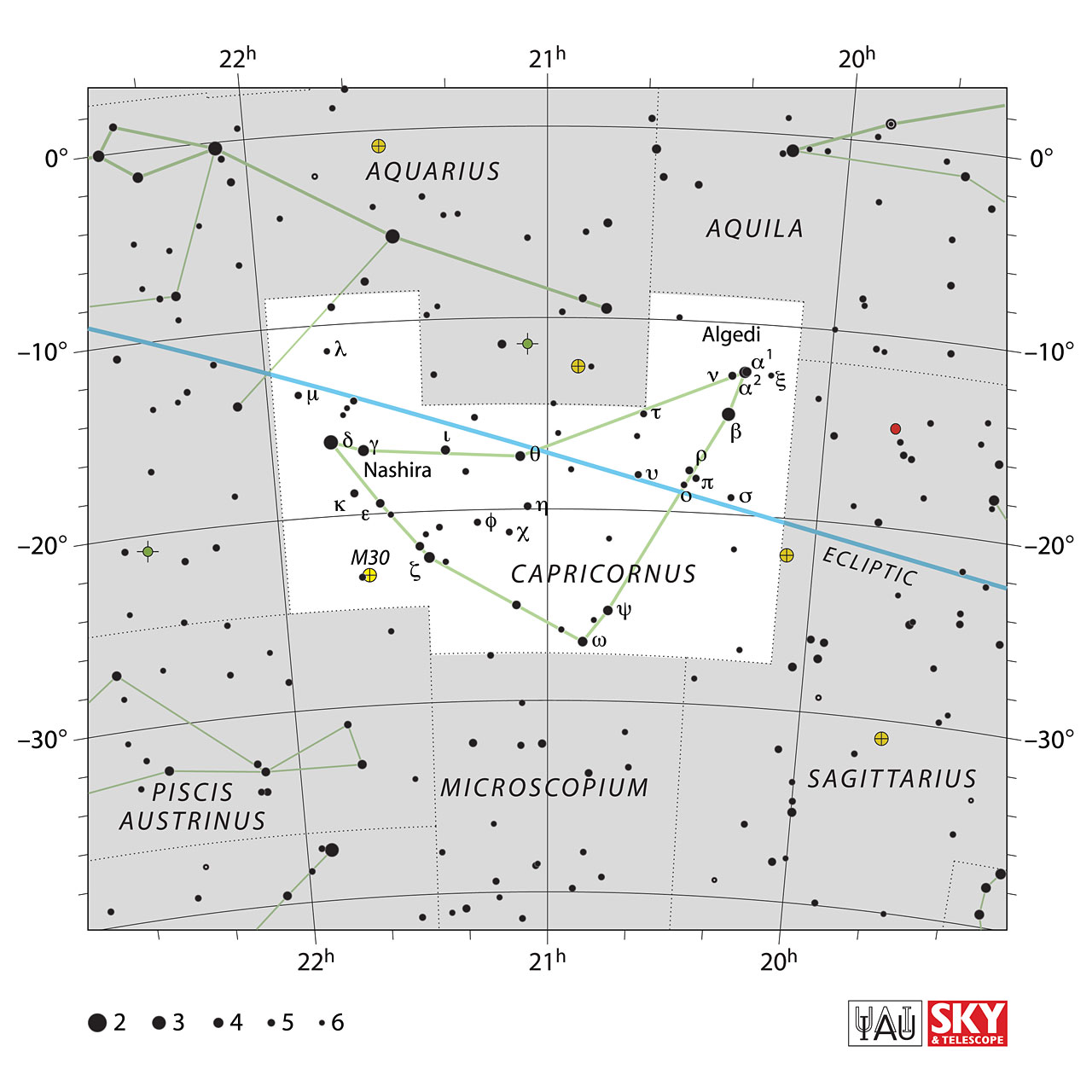Capricornus


Capricornus is the smallest of the twelve zodiacal constellations, visible in the southern sky in the months around July.
Despite lying close to the Milky Way, it contains few bright deep sky objects, with the single exception of the globular cluster M30.
It represents a bizarre mythical creature which is half goat and half fish. It is also sometimes associated with Pan, god of the countryside. The name ‘Capricornus’ means ‘horned goat’.
It lies in a part of the sky often called the ‘Sea’ since it has several water-related constellations, including Aquarius and Pisces.
In Greek Mythology Capricorn is one of the earliest constellations and has passed through the ages virtually unchanged, depicting the front half of a goat and the tail of a fish. It is also referred to in Greek and Roman mythology as the “Gateway of the Gods” through which the souls of men released at death would pass to the life hereafter. According to ancient Greek legends, Cronus was told by the oracle that one day one of his sons would grow up to be stronger than he and would eventually kill him in battle. In order to keep this from happening, Cronus had every baby boy born to him as a son killed. Some legends say he would swallow them when they were born. Knowing of this curse, Zeus’ mother gave him to some sea nymphs with instructions to take him to a far-away place where Cronus could not find him and raise him there. However, sea nymphs cannot produce milk, and so they brought a very special goat, Amalthea, to nurse him. As Zeus grew older, Amalthea also became his playmate. One day, Zeus was playing with Amalthea and broke off one of her horns. Zeus took this as a sign that he was supposed to break off his relationship with Amalthea and the sea nymphs and go fight his father, Cronus. Zeus gave the horn to the sea nymphs and Amalthea telling them that as they had always provided for his needs, so now this horn, which was now a magic horn, would always provide all the food and drink they would ever need. Zeus then left them to go and fight Cronus, his cruel father. Zeus defeated Cronus and, according to one legend, as Cronus fell to the ground, his head split open and out stepped the brothers of Zeus that Cronus had swallowed. Zeus was now the king of the gods and one of his first acts was to place the constellation Capricorn in the heavens in honor of Amalthea and the sea nymphs who had hidden and taken such good care of him.
Although the solstice during the northern hemisphere’s winter no longer takes place while the sun is in the constellation Capricornus, as it did until 130 BCE, the astrological sign called Capricorn is still used to denote the position of the solstice, and the latitude of the sun’s most southerly position continues to be called the Tropic of Capricorn, a term which also applies to the line on the Earth at which the sun is directly overhead at local noon on the day of the December solstice.
Capricorn in the Indian constellation system is called ಮಕರ (Makara)
Capricornus contains:
-
Stars
- δ-Cap (mag 2.9)
- Dabih (mag 3.1)
- Algedi (mag 3.6)
- Nashira (mag 3.7)
- ζ-Cap (mag 3.8)
- θ-Cap (mag 4.1)
- ω-Cap (mag 4.1)
- ψ-Cap (mag 4.2)
- α¹-Cap (mag 4.2)
- ι-Cap (mag 4.3)
- b-Cap (mag 4.5)
- A-Cap (mag 4.5)
- ε-Cap (mag 4.5)
- κ-Cap (mag 4.7)
- ν-Cap (mag 4.7)
- η-Cap (mag 4.8)
- ρ-Cap (mag 4.9)
- μ-Cap (mag 5.1)
- c-Cap (mag 5.1)
- HD (mag 5.1)
- φ-Cap (mag 5.2)
- υ-Cap (mag 5.2)
- 42-Cap (mag 5.2)
- τ-Cap (mag 5.2)
- 41-Cap (mag 5.2)
-
Open ClustersNone
-
Globular Clusters
- Messier 30 (mag 6.9)
-
Galaxy
- NGC 6907 (mag 11.3)
- IC 5078 (mag 12.8)
- NGC 6903 (mag 12.9)
- NGC 6924 (mag 13.5)
- IC 1313 (mag 13.5)
- IC 4999 (mag 13.5)
- IC 5005 (mag 13.6)
- IC 1386 (mag 13.8)
- NGC 7131 (mag 14.0)
- NGC 6931 (mag 14.0)
- NGC 6898 (mag 14.0)
- IC 1339 (mag 14.2)
- NGC 6912 (mag 14.3)
- IC 5088 (mag 14.4)
- IC 1412 (mag 14.4)
- NGC 7030 (mag 14.5)
- IC 1319 (mag 14.9)
- NGC 7016 (mag 14.9)
- IC 1328 (mag 14.9)
- IC 1408 (mag 14.9)
- NGC 7017 (mag 14.9)
- NGC 6897 (mag 15.0)
- NGC 7104 (mag 15.1)
- NGC 7103 (mag 15.1)
- NGC 7019 (mag 15.1)
View Capricornus in 3D 
Source: Wikipedia, in-the-sky.org
Image Courtesy: Sky&Telescope & IAU, Illustration Images linked from Urania's Mirror on Wikmedia Commons by Sidney Hall
Image Courtesy: Sky&Telescope & IAU, Illustration Images linked from Urania's Mirror on Wikmedia Commons by Sidney Hall
